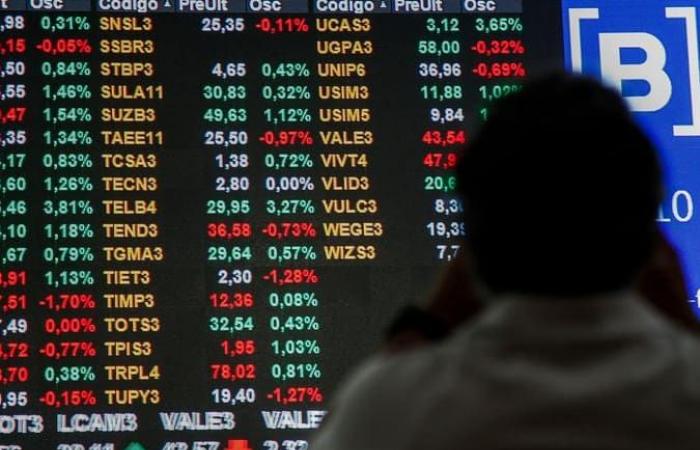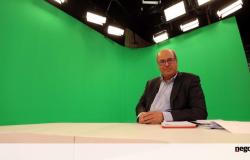Despite the drop in the quarter, the Ibovespa ended this Thursday’s trading session (28) up 0.32%, at 128,106 points | Photo: Miguel Schincariol / AFP
Even registering weakness at the opening, the Brazilian stock exchange quickly reversed the losses and secured an increase this Thursday (28), driven by advances in Petrobras and Prio, which were among the most traded of the session. As a result, Ibovespa ended the day with an increase of 0.32%, at 128,106 points.
Despite this Thursday’s rise, the quarterly balance for the main index on the Brazilian Stock Exchange is negative. Between January and March, the Ibovespa accumulated a drop of 4.5%, in a period marked by the outflow of foreign resources, amid doubts about the beginning of the interest rate easing cycle in the United States, and the absence of catalysts in the local market. .
“The macro scenario is weak, with no major relevant triggers on the radar. Therefore, the Stock Exchange’s liquidity is reduced, we are experiencing an outflow of foreign flows. All of this has affected, and in general, the micro dynamics are ruling. Companies with good results are performing better, and those with bad numbers, worse”, says Felipe Moura, analyst at Finacap.
In this Friday’s session, the biggest rise of the day was from Marfrig, which soared more than 10% after the release of its financial statement for the fourth quarter of 2023. The company reversed losses and made a profit of R$11.8 million in the period. Advances by Ambev, Vale and Banco do Brasil also helped Ibovespa.
In terms of foreign exchange, the dollar has been rising since the beginning of the day, still pressured by uncertainty about the start of interest rate cuts by the Fed (American central bank). The American currency closed the session with an increase of 0.68%, quoted at R$5.014, and accumulates an increase of 3.33% in the quarter.
Investors also reflected on the release of the Central Bank’s Inflation Report, which improved its forecast for credit growth and economic growth for the year. The authority stated, however, that headline inflation and the average of the cores that measure price increases rose to levels that exceed the inflation target.
“This upward surprise was due to the administered prices and food at home segments”, stated the BC, highlighting that there was an upward surprise in the underlying component (which excludes volatile items) of the services segment.
In the United States, inflation and employment data were released, which were in line with expectations. The GDP (Gross Domestic Product) result, however, which was also released in the morning, surprised upwards: the American economy grew 3.4% in the fourth quarter of 2023, above projections of 3.2%.
The release of the data comes after Fed Director Christopher Waller said that recent inflation data confirms that the US central bank should postpone the long-awaited interest rate cut.
In this scenario, uncertainties about the beginning of American monetary easing, which have been weighing on local assets and the dollar, were reinforced.
“Doubts persist about when the Fed will start the cycle of lowering interest rates. The stronger GDP works against it, as does Waller’s speech. The bets continue for June, but until then it will be necessary to observe the day to day and economic indicators”, says Alexsandro Nishimura, economist and partner at Nomos.
Dollar negotiations were also influenced by the formation of Ptax, an exchange rate calculated by the Central Bank that serves as a reference for the settlement of futures contracts. At the end of each month, financial agents usually try to direct it to levels that are more convenient for their positions, whether they are bought or sold in dollars.
In futures markets, yield curves rose, following US bond yields after Waller’s speech.
Despite the uncertain scenario, the fall in the Brazilian Stock Exchange is mainly linked to external reasons, and the local situation continues to show favorable signs for investments.
The Itaú BBA investment strategy team, for example, highlights that Brazil’s economic activity remains resilient – and even stronger than expected – and inflation remains at low levels.
“The correction we observed at the beginning of the year on the Brazilian Stock Exchange opens a good window of buying opportunity. In addition to a benign international scenario, with the expectation of the beginning of a cycle of interest cuts by the Fed, which should serve as an impetus for global risk assets, we see several factors in favor of the stock market’s appreciation. Among them, the ongoing local monetary easing, the robust growth in profits of Brazilian companies ahead”, say the BBA analysts.
In this scenario, the bank decided to increase its allocation on the Brazilian Stock Exchange. They warn, however, about the fiscal scenario, noting that there has been a deterioration in results, despite the recent positive surprise in revenue.
Analysts are also skeptical about meeting the zero deficit target this year, projecting the number to be 0.7% of GDP. (Marcelo Azevedo / Folhapress)
—
THE TIME reinforces the commitment to quality, professional and Minas Gerais journalism. Our newsroom produces responsible information every day that you can trust.
Follow THE TIME on Facebook, on Twitter and on Instagram. Help grow our community.






